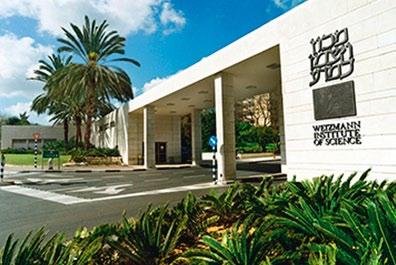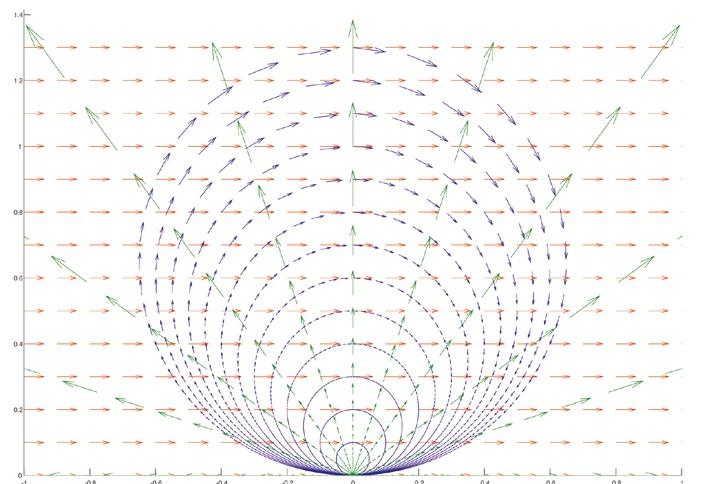
9 minute read
RelRepDist
Mathematicians have long used representation theory to study linear symmetries and algebraic structures, now researchers are developing new theoretical tools to approach the subject and gain new insights. We spoke to Dr Dmitry Gourevitch about his work in relative representation theory, which brings together elements of several branches of mathematics
Background images describe the action of the group of 3x3 matrices with unit determinant over real and p-adic local fields on its quotient by its maximal compact subgroup, courtesy of Prof. A. Aizenbud and his students Y. Hendel and I. Glazer.
Branching out across maths disciplines
Many objects in mathematics, physics, and other sciences possess natural symmetries, and over the course of history a number of theories and conceptual frameworks have been developed to study them. Based at the Weizmann Institute of
Science in Israel, Dr Dmitry Gourevitch specialises in a field called representation theory, which concerns the study of linear symmetries. “There are lots of symmetrical figures, like circles, squares, cubes, while many molecules are quite symmetrical for example,” he says.
A key topic in Dr Gourevitch’s research is the study of groups, a specific type of algebraic structure which is closely related to the idea of symmetry. “A group is a set with an invertible operation, such as multiplication or addition. Numbers (integral or real) are one example of a group, while another example is a group of permutations of a deck of cards – the set of all the possible ways to reorder it. There are all kinds of groups – like symmetries, they usually act on something,” outlines Dr Gourevitch. “Then there are also subgroups to consider.”
mathematics – analysis, geometry and algebra
Representation theory
Researchers are investigating this topic further in the RelRepDist project, an ERCbacked initiative which aims to develop new theoretical tools to describe and study these groups in greater depth.
“It’s difficult to compute something that is non-linear, yet the study of linear models should be much easier, and indeed it is,” continues Dr Gourevitch. “Group representation theory is the study of linear symmetries. A representation of a group is a way to present its quotient as a group of symmetries of a linear space.”
The study of representations of finite groups started around 120 years ago. All the simple finite groups were classified around 10 years ago, and in some sense also all of their representations. The next step is the study of infinite compact Lie groups. For example, the group of all possible rotations in the space is a compact Lie group since it is closed, bounded and smooth. By now, this subject had also become quite classical. The majority of the groups Dr Gourevitch and his colleagues are interested in are infinite and non-compact however, like the group of all invertible 3 by 3 matrices. They consider representations of such groups in symmetries of infinitedimensional spaces. This field has been intensively studied over the years, and significant progress has been made. “On one hand, the irreducible representations have been classified to some extent by Langlands,” says Dr Gourevitch. These answers are not perfect however, as the description is very complicated and implicit. “The existing classification describes some representations as small parts of huge spaces.”
Generalized functions, or distributions

The main tool being used by Dr. Gourevitch and his colleagues is the theory of distributions, or generalized functions. This theory originated in 1920s with the work of the physicist Dirac, who used in his work the so-called ‘delta-function’ (δ0). Dirac described it as a function that has zero value everywhere except the point zero, while the value at zero is infinite, and due to this infinity the total integral becomes one. Mathematicians at first believed that such a function could not exist, since the value at a single point has no effect on the integral. However, physicists continued working with this function and obtained meaningful results. Finally, in the 1950s the French mathematician Laurent Schwartz developed the notion of a generalized function, showing that while Dirac’s delta makes no sense as a function, it is a well-defined generalized function, or distribution. In the 1960s the theory was enhanced by Gelfand, and since then by many others. Distributions became a classical tool, but the theory is far from being complete. One of the goals of the project is to study distributions with a given group of symmetries, following Gelfand, Kazhdan, Harish-Chandra, Bernstein and others.
p-adic numbers
The project’s research also touches on some other important mathematical concepts, including real and rational numbers. The group of real numbers includes all rational numbers. “Rational numbers are simple fractions. For example 5/7 is a rational number, as is -5/7, yet the square root of 2 (√2) is not a rational number, as it cannot be presented as a simple fraction. It’s still a real number however, and it appears in the real world, as the length of the hypotenuse of a right-angled triangle for example,” explains Dr Gourevitch. “Then π is another real number. A real number may be difficult to precisely quantify. For example π can be computed to thousands of decimal places; while 22/7 is a fairly accurate approximation for π, it’s still an approximation. A real number is defined by successive approximation, i.e. by a sequence of rational numbers that approximates it to any given level of precision” outlines Dr Gourevitch. “Thus, a real number is defined using rational numbers.”
“Surprisingly, it is also possible to use rational numbers to define a totally different field of numbers - the so-called p-adic numbers.” says Dr Gourevitch. “To do that one uses other absolute values. The notion of absolute value seems to be simple: it the “size” of the number, without its sign. For example, the absolute value of 5 is 5, while the absolute value of -5 is also 5. However, if we just list the basic properties of the absolute value and ask whether there are other functions with these properties, the answer is apparently ‘yes’ – there is a p-adic absolute value for any prime number p. For example, the 2-adic absolute value is defined to be 2 on ½, to be ½ on 2, and to be 1 on all odd integers. A 2-adic number is a binary sequence that has infinitely many digits before the binary point and finitely many digits after it, as opposed to a real number that has finitely many points before the decimal point and infinitely many digits after it. While these numbers may seem strange, they help to find integer solutions for algebraic equations. They are also useful in other parts of number theory – a wide field of mathematics that has attracted scholars since ancient times.”
“Within the scope of the RelRepDist project, I would like to find an approach to the study of symmetric distributions that will work uniformly for algebraic spaces defined over real numbers and those defined over p-adic numbers,” says Dr. Gourevitch.
Full Project Title
Relative representation theory and 1.2 distributions on reductive groups over local fields (RelRepDist)
Project Objectives
Let F be a local field, e.g. the field of real numbers or the field of p-adic numbers. Let G be an algebraic reductive F-group, e.g. the group of invertible n-by-n matrices over F. Objectives: 1. Develop tools for the study of G-equivariant distributions on spaces with 1G-action, that will work uniformly for all F. 2. Study the action of G on spaces of functions on quotients of G by its unipotent subgroups.
Project Funding
The project is funded under the ERCStG-2014 - ERC Starting Grant 637912. Dr Dmitry Gourevitch is the incumbent of the Dr. A. Edward Friedman Career Development Chair in Mathematics.
Project C0-authors
• Professor Avraham Aizenbud 0.8 • Professor Siddhartha Sahi

Contact Details
Project Coordinator, Dr Dmitry Gourevitch Faculty of Mathematics and Computer Science The Weizmann Institute of Science 234 Herzl St. PO Box 26 Rehovot 7610001 Israel T: +(972) 8-934-2171 E: dimagur@weizmann.ac.il 0.6 W: http://cordis.europa.eu/project/ rcn/193540_en.html
Dr Dmitry Gourevitch
0.4
Dr Dmitry Gourevitch is Assistant Professor in the Department of Mathematics at the Weizmann Institute of Science in Israel. He previously held academic positions in both the US and Israel, before taking up his current position in 2011.
0.2
Dr Gourevitch is investigating how representations of certain groups behave when restricted to sub-groups. This subject is called relative representation theory, or symmetry breaking. While representation theory was originally considered to be primarily related to algebra, as groups and linear spaces are algebraic objects, Dr Gourevitch says his research also touches on several other branches of mathematics. “When we study infinite-dimensional representations, functional analysis comes in. Then, when we study relative representation theory, geometry also comes in. So it’s at the crossroads of three major parts of mathematics – analysis, geometry and algebra,” he outlines.
Another name for relative representation theory is non-commutative harmonic analysis. It is a generalization of the classical harmonic analysis that originated in the works of Fourier 200 years ago, and which since then has found numerous applications in physics, engineering and computer science. For example, the Fourier transform is constantly used by our cell phones and computers. Thus, one may hope that applications arising from noncommutative harmonic analysis will be identified in due time.
RelRepDist project
The RelRepDist project also holds wider relevance – to number theory, string theory and integral geometry. While the field of integral geometry has its roots in fundamental investigation, it has given rise to tomography techniques, which today are commonly used in medical imaging. Relative representation theory could inform future technical development, yet this is of course difficult to predict, and the project is motivated more by intellectual curiosity than the possibility of applications. A number of collaborations have been established, and Dr Gourevitch plans to pursue further research in this area in future. “I was contacted by some physicists working in string theory. They had a precise mathematical question, and we are investigating this question together,” he says.
This is complex work, and research in this area demands deep knowledge, so training is essential to the long-term development of the field. Dr Gourevitch works with four PhD students and two post-doctoral trainees in his group, while he is also organizing international activities to help lay the foundations for continued research. “Together with Profs. Aizenbud, Bernstein and Lapid, I’m holding a two-month activity in May and June with the support of the ERC and some Israeli funds. Over 50 researchers came from across the world to attend,” he says. “The ERC funding gives us a unique opportunity to hold several workshops in adjacent fields, in back-to-back time periods. Our workshops consist of seminars and mini-courses, thus allowing the leading scientists in the area to present not only their latest results, but also deeper insights, summarizing the whole development of the field in the 21st century.”

The Weizmann Institute of Science, Israel.











